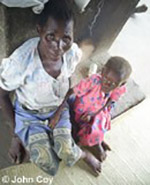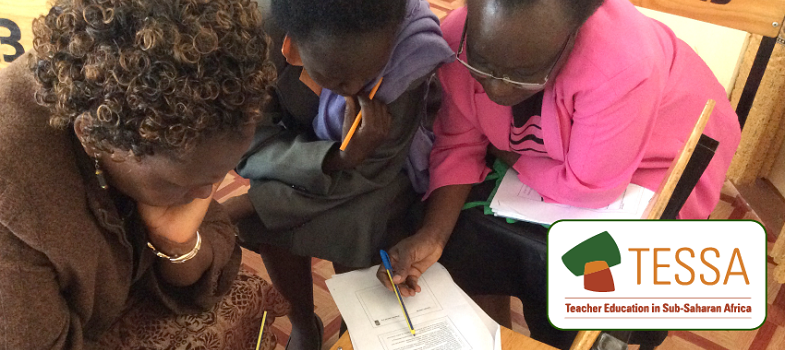Resource 1: HIV and AIDS in Africa
![]() Background information / subject knowledge for teacher
Background information / subject knowledge for teacher
http://www.avert.org/ [Tip: hold Ctrl and click a link to open it in a new tab. (Hide tip)]
This is the web homepage of an organisation called AVERT, an international HIV and AIDS charity based in the UK, with the aim of AVERTing (preventing) HIV and AIDS worldwide.
You will find a good deal of useful information for teachers on this site.
HIV and AIDS useful facts and statistics for Sub-Saharan Africa
The AVERT site gives figures which your pupils may ask about. It also has a very useful guide to understanding the statistics.
Here is the summary of statistics for Africa. You will find more details for your own country on the website.
Sub-Saharan Africa is more heavily affected by HIV and AIDS than any other region of the world. An estimated 24.5 million people were living with HIV at the end of 2005 and approximately 2. 7 million new infections occurred during that year. In just the past year the epidemic has claimed the lives of an estimated 2 million people in this region. More than 12 million children have been orphaned by AIDS.

The extent of the epidemic is only now becoming clear in many African countries, as increasing numbers of people with HIV are becoming ill. In the absence of massively expanded prevention, treatment and care efforts, it is expected that the AIDS death toll on the continent will continue to rise. This means that the epidemic's impact on these societies will be felt most strongly in the course of the next ten years and beyond. Its social and economic consequences are already widely felt, not only in the health sector but also in education, industry, agriculture, transport, human resources and the economy in general.
How are different countries in Africa affected?
HIV prevalence rates vary greatly between African countries. In Somalia and Senegal the prevalence is under 1% of the adult population, whereas in South Africa and Zambia around 15–20% of adults are infected.
In four southern African countries, the national adult HIV prevalence rate has risen higher than was thought possible and now exceeds 20%. These countries are Botswana (24.1%), Lesotho (23. 2%), Swaziland (33. 4%) and Zimbabwe (20.1%).
West Africa has been less affected by HIV, but the prevalence rates in some countries are creeping up. Prevalence is estimated to exceed 5% in Cameroon (5.4%), Côte d'Ivoire (7.1%) and Gabon (7.9%).
Until recently, the national prevalence rate has remained relatively low in Nigeria, the most populous country in Sub-Saharan Africa. The rate has grown slowly from below 2% in 1993 to 3. 9% in 2005. But some states in Nigeria are already experiencing HIV infection rates as high as those now found in Cameroon. Already around 2. 9 million Nigerians are estimated to be living with HIV.
Adapted from: http://www.avert.org/ subaadults.htm (Accessed 2008)
HIV and AIDS in Nigeria

The first case of AIDS was identified in Nigeriain 1986 and HIV prevalence rose from 1. 8% in 1988 to 5.8% in 2001. Since 1991, the Federal Ministry of Health has carried out a National HIV/syphilis sentinel seroprevalence survey every two years. The 2003 survey estimated that there were 3,300,000 adults living with HIV/AIDS in Nigeria, and 1,900,000 (57%) of these were women.
In the 2003 survey, the national HIV prevalence had dropped to 5% from 5.8% in 2001. However, it found that State prevalence rates varied from as low as 1. 2% in Osun State to as high as 12% in CrossRiverState. Overall, 13 of Nigeria’s 36 states had an HIV prevalence over 5%. These figures give support to the claim that there are explosive, localised epidemics in some States.
At 5.6%, HIV/AIDS prevalence is highest among young people between the ages of 20 and 24, compared with other age groups. Nigeria’s STD/HIV Control estimates that over 60% of new HIV infections are in the 15–25 year old age group.4
In 2005, it was estimated there were 220,000 deaths from AIDS, and 930,000 AIDS orphans living in Nigeria. There has been an alarming increase in the number of HIV positive children in recent years, 90% of whom contract the virus from their mothers. Currently, very few Nigerians have access to basic HIV/AIDS prevention, care, support or treatment services.
How is HIV transmitted in Nigeria?
Some 80% of HIV infections in Nigeria are transmitted by heterosexual sex. Factors contributing to this include a lack of information about sexual health and HIV, low levels of condom use and high levels of sexually transmitted infections (STIs) such as chlamydia and gonorrhoea, which make it easier for the virus to be transmitted.
Blood transfusions are responsible for about 10% of all HIV infections. There is a high demand for blood because of road traffic accidents, blood loss from surgery and childbirth, and anaemia from malaria. As there is no coordinated national blood supply system, blood isn’t routinely tested for HIV, and a recent study found that 4% of blood donors in Lagos were HIV positive.
The remaining 10% of HIV infections are acquired through other routes such as mother-to-child transmission, homosexual sex and injecting drug use. The rate of mother-to-child transmission in Nigeria has gone up in recent years as the number of HIV positive women has increased.5
3. Using role play and scenarios



